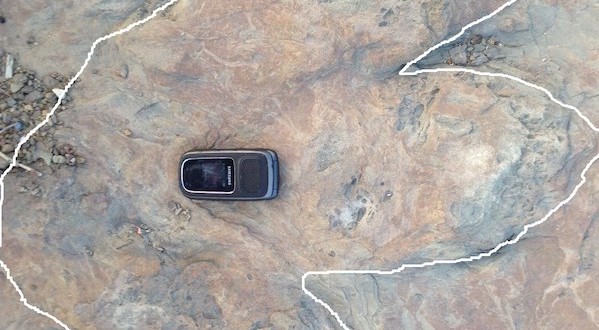Only 14 tyrannosaur tracks have been discovered worldwide. Many of those have been found within the Tumbler Ridge Global Geopark, but the one found by University of British Columbia Geology student Carina Helm on August 30th was less than 10 km away from the town.
“My dad and I were returning in the evening from repairing boardwalks on one of the hiking trails, when I told him I knew of some big exposed rock slabs. We worked out that these were maybe from an age that could feature dinosaur tracks, so we decided to make a detour to have a look,” Helm said.
“The very first rock I went to, right beside the road, had this huge track-shape on it with three toes. I thought, ‘Surely that is too big to be a footprint?’ but I showed it to my dad and next thing he was on his cell-phone to Rich McCrea telling him about the find.”
Other tyrannosaur tracks around the world have been found in Mongolia, New Mexico and Alberta, but the majority—including the only known tyrannosaur trackways in the world—were discovered in inside the newly-established Tumbler Ridge Global Geopark.
The remote location of most of those finds make Helm’s discovery significant in contrast, as it is close to Tumbler Ridge and easily accessible from the road.
The day following Helm’s discovery, Rich McCrea and Lisa Buckley, palaeontologists at the Peace Region Palaeontology Research Centre (PRPRC) in Tumbler Ridge, travelled to the tracksite and were able to confirm that the footprint had indeed been made by a tyrannosaur.
The track measures 59-centimetres in length, but would have at one time been much larger, as can be observed by the fact that the tip of the longest toe and claw have eroded away.
McCrea and Buckley also concluded that the tyrannosaur that made the print was likely similar to the Albertasaurus.
“It can sometimes be a challenge to identify the maker of a single print, especially one that has been weathered by the elements,” said McCrea. Even with the tips of the digits (the claw impressions) eroded away, the footprint found by Carina Helm still possesses characteristics that make it identifiable as the product of a meat-eating (theropod) dinosaur. In addition to the morphological features of the footprint, which bears great similarity to the ones discovered in the fall of 2011 by Mr. Aaron Fredlund (subsequently named Bellatoripes fredlundi), the size of the print and the age of the rocks it was found in provide further evidence that the track-maker was a tyrannosauroid.”
Incidentally, the first tyrannosauroid tooth found in British Columbia was found by McCrea in 2004, in the same area as this find.
Helm’s discovery was not her first of the season; on the same day she was part of the team which discovered the smallest track (six centimetres) to be found in this region.
She also discovered two other trackways in a canyon of much older rock layers earlier this summer.
“It is exciting to be able to contribute to science and the Geopark in this way,” said Helm.
Agencies/Canadajournal
 Canada Journal – News of the World Articles and videos to bring you the biggest Canadian news stories from across the country every day
Canada Journal – News of the World Articles and videos to bring you the biggest Canadian news stories from across the country every day



